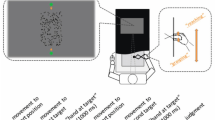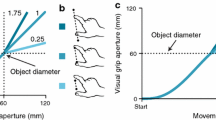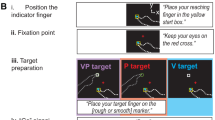Abstract
The goal of this study was to determine whether the sensory nature of a target influences the roles of vision and proprioception in the planning of movement distance. Two groups of subjects made rapid, elbow extension movements, either toward a visual target or toward the index fingertip of the unseen opposite hand. Visual feedback of the reaching index fingertip was only available before movement onset. Using a virtual reality display, we randomly introduced a discrepancy between actual and virtual (cursor) fingertip location. When subjects reached toward the visual target, movement distance varied with changes in visual information about initial hand position. For the proprioceptive target, movement distance varied mostly with changes in proprioceptive information about initial position. The effect of target modality was already present at the time of peak acceleration, indicating that this effect include feedforward processes. Our results suggest that the relative contributions of vision and proprioception to motor planning can change, depending on the modality in which task relevant information is represented.






Similar content being viewed by others
References
Adamovich SV, Berkinblit MB, Fookson O, Poizner H (1998) Pointing in 3D space to remembered targets. I. Kinesthetic versus visual target presentation. J Neurophysiol 79:2833–2846
Bagesteiro LB, Sarlegna FR, Sainburg RL (2006) Differential influence of vision and proprioception on control of movement distance. Exp Brain Res 171:358–370
Baraduc P, Wolpert DM (2002) Adaptation to a visuomotor shift depends on the starting posture. J Neurophysiol 88:973–981
van Beers RJ, Sittig AC, Denier van der Gon JJ (1996) How humans combine simultaneous propiroceptive and visual position information. Exp Brain Res 111:253–261
van Beers RJ, Sittig AC, Denier van der Gon JJ (1999) Integration of proprioceptive and visual position-information: an experimentally supported model. J Neurophysiol 81:1355–1364
Blouin J, Teasdale N, Bard C, Fleury M (1993) Directional control of rapid arm movements : the role of the kinetic visual feedback system. Can J Exp Psychol 47:678–696
Bock O, Arnold K (1993) Error accumulation and error correction in sequential pointing movements. Exp Brain Res 95:111–117
Brown SH, Cooke JD (1981) Responses to force perturbations preceding voluntary human arm movements. Brain Res 220:350–355
Brown LE, Rosenbaum DA, Sainburg RL (2003a) Limb position drift: implications for control of posture and movement. J Neurophysiol 90:3105–3118
Brown LE, Rosenbaum DA, Sainburg RL (2003b) Movement speed effects on limb position drift. Exp Brain Res 153:266–274
Darling WG, Miller GF (1993) Transformations between visual and kinesthetic coordinate systems in reaches to remembered object locations and orientations. Exp Brain Res 93:534–547
Desmurget M, Rossetti Y, Prablanc C, Stelmach GE, Jeannerod M (1995) Representation of hand position prior to movement and motor variability. Can J Physiol Pharmacol 73:262–272
Desmurget M, Rossetti Y, Jordan M, Meckler C, Prablanc C (1997) Viewing the hand prior to movement improves accuracy of pointing performed toward the unseen contralateral hand. Exp Brain Res 115:180–186
Desmurget M, Grafton ST, Vindras P, Gréa H, Turner RS (2004) The basal ganglia network mediates the planning of movement amplitude. Eur J Neurosci 19:2871–2880
Elliott D, Carson RG, Goodman D, Chua R (1991) Discrete vs. continuous visual control of manual aiming. Hum Mov Sci 10:393–418
Favilla M, Hening W, Ghez C (1989) Trajectory control in targeted force impulses VI. Independent specification of response amplitude and direction. Exp Brain Res 75:280–294
Flanagan JR, Rao AK (1995) Trajectory adaptation to a nonlinear visuomotor transformation: evidence of motion planning in visually perceived space. J Neurophysiol 74:2174–2178
Flanders M, Cordo PJ (1989) Kinesthetic and visual control of a bimanual task: specification of direction and amplitude. J Neurosci 9:447–453
Fu QG, Flament D, Coltz JD, Ebner TJ (1995) Temporal encoding of movement kinematics in the discharge of primate primary motor and premotor neurons. J Neurophysiol 73:836–854
Gentilucci M, Jeannerod M, Tadary B, Decety J (1994) Dissociating visual, kinesthetic coordinates during pointing movements. Exp Brain Res 102(2):359–366
Georgopoulos AP, DeLong MR, Crutcher MD (1983) Relations between parameters of step-tracking movements and single cell discharge in the globus pallidus and subthalamic nucleus of the behaving monkey. J Neurosci 3:1586–1598
Ghez C (1979) Contributions of central programs to rapid limb movement in the cat. In: Wilson VJ, Asanuma H (eds) Integration in the nervous system. Igaku-Shoin, Tokyo, New York
Ghez C, Gordon J, Ghilardi MF (1995) Impairments of reaching movements in patients without proprioception. II. Effects of visual information on accuracy. J Neurophysiol 73:361–372
Ghez C, Krakauer J, Sainburg RL, Ghilardi MF (1999) Spatial representations and internal models of limb dynamics in motor learning. In: Gazzaniga MS (ed) The new cognitive neurosciences. The MIT Press, Cambridge
Gielen CCAM, van den Oosten K, Pull ter Gunne F (1985) Relation between EMG activation patterns and kinematic properties of aimed arm movements. J Mot Behav 17:421–442
Gordon J, Ghez C (1987a) Trajectory control in targeted force impulses. II. Pulse height control. Exp Brain Res 67:241–252
Gordon J, Ghez C (1987b) Trajectory control in targeted force impulses. III. Compensatory adjustments for initial errors. Exp Brain Res 67:253–269
Gottlieb GL, Corcos DM, Agarwal GC (1989) Organizing principles for single-joint movements. I. A speed-insensitive strategy. J Neurophysiol 62:342–357
Holmes NP, Spence C (2005) Visual bias of unseen hand position with a mirror: spatial and temporal factors. Exp Brain Res 166:489–497
Krakauer JW, Pine ZM, Ghilardi MF, Ghez C (2000) Learning of visuomotor transformations for vectorial planning of reaching trajectories. J Neurosci 20:8916–8924
Larish DD, Volp CM, Wallace SA (1984) An empirical note on attaining a spatial target after distorting the initial conditions of movement via muscle vibration. J Mot Behav 16:76–83
Lateiner JE; Sainburg RL (2003) Differential contributions of vision and proprioception to movement accuracy. Exp Brain Res 151:446–454
McIntyre J, Stratta F, Droulez J, Lacquaniti F (2000) Analysis of pointing errors reveals properties of data representations and coordinate transformations within the central nervous system. Neural Comput 12:2823–2855
Messier J, Kalaska JF (2000) Covariation of primate dorsal premotor cell activity with direction and amplitude during a memorized-delay reaching task. J Neurophysiol 84:152–165
Nougier V, Bard C, Fleury M, Teasdale N, Cole J, Forget R, Paillard J, Lamarre Y (1996) Control of single-joint movements in deafferented patients: evidence for amplitude coding rather than position control. Exp Brain Res 109:473–482
Oldfield RC (1971) The assessment and analysis of handedness: the Edinburgh inventory. Neuropsychologia 9:97–113
Paillard J (1996) Fast and slow feedback loops for the visual correction of spatial errors in a pointing task: a reappraisal. Can J Physiol Pharmacol 74:401–417
Prablanc C, Echallier JF, Jeannerod M, Komilis E (1979) Optimal response of eye and hand motor systems in pointing at a visual target. II. Static and dynamic visual cues in the control of hand movement. Biol Cybern 35:183–187
Prodoehl J, Gottlieb GL, Corcos DM (2003) The neural control of single degree-of-freedom elbow movements. Effect of starting joint position. Exp Brain Res 153:7–15
Riehle A, Requin J (1989) Monkey primary motor and premotor cortex: single-cell activity related to prior information about direction and extent of an intended movement. J Neurophysiol 61:534–549
Rosenbaum DA (1980) Human movement initiation: specification of arm, direction, and extent. J Exp Psychology 109:444–474
Rossetti Y, Desmurget M, Prablanc C (1995) Vectorial coding of movement: vision, proprioception, or both? J Neurophysiol 74:457–463
Sainburg RL, Schaefer SY (2004) Interlimb differences in control of movement extent. J Neurophysiol 92:1374–1383
Sainburg RL, Poizner H, Ghez C (1993) Loss of proprioception produces deficits in interjoint coordination. J Neurophysiol 70:2136–2147
Sainburg RL, Ghilardi MF, Poizner H, Ghez C (1995) Control of limb dynamics in normal subjects and patients without proprioception. J Neurophysiol 73:820–835
Sainburg R L, Ghez C, Kalakanis D (1999) Intersegmental dynamics are controlled by sequential anticipatory, error correction, and postural mechanisms. J Neurophysiol 81:1045–1056
Sainburg RL, Lateiner JE, Latash ML, Bagesteiro LB (2003) Effects of altering initial position on movement direction and extent. J Neurophysiol 89:401–415
Scheidt RA, Conditt MA, Secco EL, Mussa-Ivaldi FA (2005) Interaction of visual and proprioceptive feedback during adaptation of human reaching movements. J Neurophysiol 93:3200–3213
Sober SJ, Sabes PN (2003) Multisensory integration during motor planning. J Neurosci 23:6982–6992
Sober SJ, Sabes PN (2005) Flexible strategies for sensory integration during motor planning. Nature Neurosci 8:490–497
Soechting JF, Flanders M (1989a) Errors in pointing are due to approximations in sensorimotor transformations. J Neurophysiol 62:595–608
Soechting JF, Flanders M (1989b) Sensorimotor representations for pointing to targets in three-dimensional space. J Neurophysiol 62:582–594
Turner RS, Anderson ME (1997) Pallidal discharge related to the kinematics of reaching movements in two dimensions. J Neurophysiol 77:1051–1074
Vindras P, Desmurget M, Viviani P (2005) Error parsing in visuomotor pointing reveals independent processing of amplitude and direction. J Neurophysiol 94:1212–1224
Wolpert DM, Ghahramani Z, Jordan MI (1995) Are arm trajectories planned in kinematic or dynamic coordinates? An adaptation study. Exp Brain Res 103:460–470
Acknowledgments
We would like to thank Ewelina Styczynska for help in data collection. This research was funded by the National Institute of Health (NICHD Grant R01HD39311).
Author information
Authors and Affiliations
Corresponding author
Rights and permissions
About this article
Cite this article
Sarlegna, F.R., Sainburg, R.L. The effect of target modality on visual and proprioceptive contributions to the control of movement distance. Exp Brain Res 176, 267–280 (2007). https://doi.org/10.1007/s00221-006-0613-5
Received:
Accepted:
Published:
Issue Date:
DOI: https://doi.org/10.1007/s00221-006-0613-5




